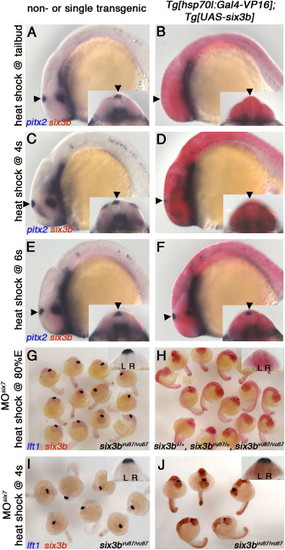
Six3 Misexpression Can Repress Diencephalic Nodal Activity If Induced by the Beginning of Somitogenesis Tg[hsp70l:Gal4-VP16]vu22;Tg[UAS-six3b]vu156 (B, D, and F) and single or nontransgenic siblings (A, C, and E), heat-shocked at tailbud (10 hpf) (A and B), 4s stage (C and D), or 6s stage (E and F). Arrowheads point at the left-sided dorsal diencephalic domain of Nodal activity represented by pitx2 expression. (G–J) Embryos from a cross between six3bvu87/+;Tg[hsp70l:Gal4-VP16]vu22 heterozygous and six3bvu87/+;Tg[UAS-six3b]vu156 heterozygous fish, which were injected with MOsix7 and heat-shocked at 80% epiboly (80%E) (G and H) or 4s stage (I and J). Insets are dorsoposterior view of the same embryo (A–F) or a representative embryo (G–I). L, left; R, right. Embryos are 22–24s stage. Genotypes in (G), (I), and (J) were inferred from clearly reduced eye size, demonstrating that embryos are six3b/six7 deficient. Because inducing six3b expression by heat shock at 80%E rescues the reduced eye size in six3b/six7-deficient embryos, embryos in (H) were PCR genotyped and the presence of all genotypes at expected ratios was confirmed.
|

